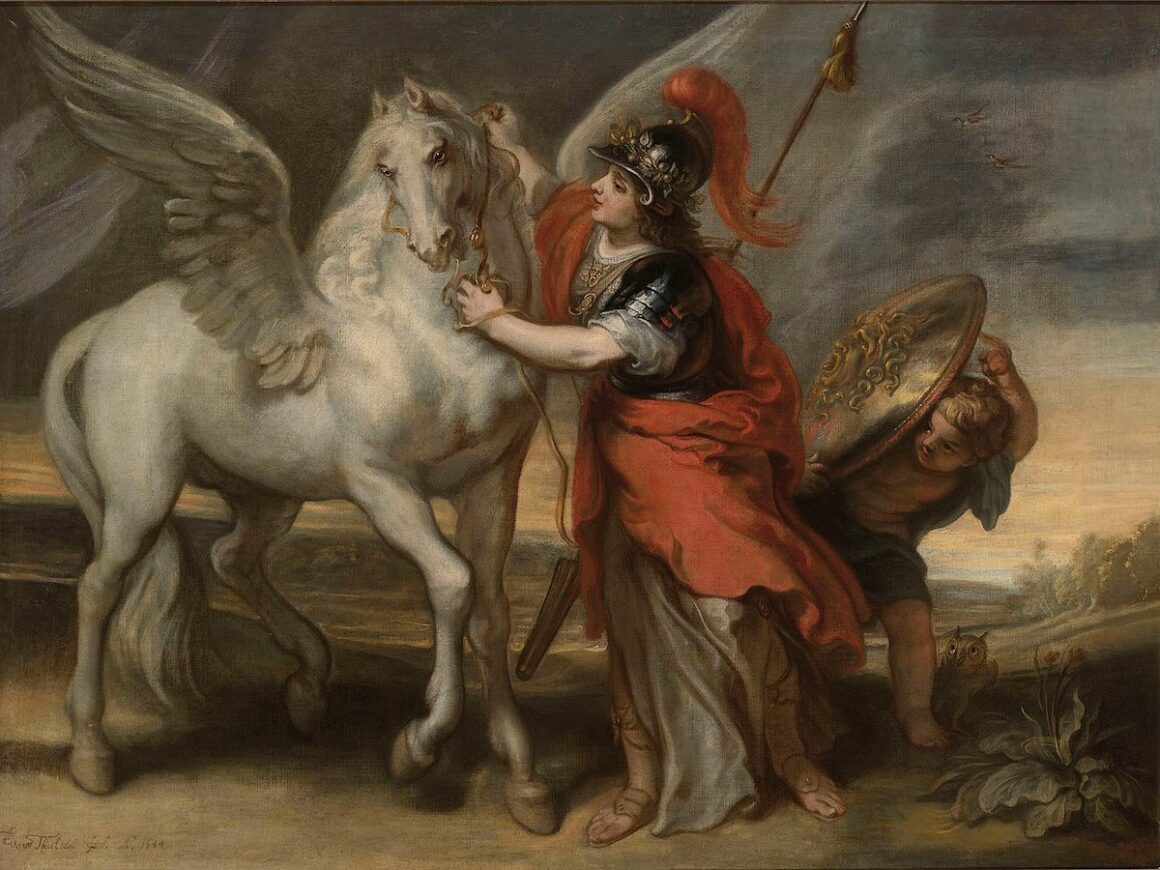Pegasus is a white, winged horse in Greek mythology who remains famous today for his strength and power. He helped Bellerophon defeat the Chimaera, carried thunderbolts in a chariot for Zeus, and later became a constellation. His name comes from the Greek word for springs, which makes sense since his father was Poseidon, the God of the sea, storms, horses, and earthquakes.

Horses were status symbols in ancient Greece. They represented wealth and power. Horses were revered and often depicted in art. The Greeks believe that Poseidon, the God of horses, among other things, created the animals and shared them with the people.
Pegasus, a son of Poseidon, is one of the most famous horses in Greek mythology. He is also universally known beyond the realms of Greek mythology. It’s a household name today, with non-equestrians and historians knowing his name and story. Greek mythology dates back at least 2,700 years, with the earliest versions recorded by Homer and Hesiod.

Greek Mythology
Pegasus and his brother Chrysaor are the children of Poseidon and Medusa. Poseidon, one of Zeus’s brothers was the God of the sea, storms, horses, and earthquakes. Medusa was a beautiful Gorgon or monster. But she was also a mortal. Athena, Zeus’s daughter and the goddess of war, turned her hair to serpents and made her face so ugly that anyone who looked at it turned to stone.
Poseidon defiled Medusa in Athena’s temple. This caused Athena’s reaction of creating serpent hair and an ugly face. Perseus beheaded the pregnant Medusa on instruction from Athena, and her two sons sprang from her neck.
Pegasus was a white stallion with wings. Although there are some versions where he is a darker color, almost black. However, most histories agree that the horse was white. He was wild, free-roaming, and also immortal since he was the child of Poseidon. Pegasus means winged horse and is also associated with water springs. Pegasus is known for his strength, ability to fly, beauty, and for creating water.
Water Springs
Poseidon was able to create water, and Pegasus had this same characteristic. A water spring appeared when he stamped his hoof. There are two springs in Greece called Hippocrene. Both are said to be created when his hoof struck the stone.
Hippocrene means horse spring in Greek. The more famous of these springs is located on Mount Helicon, the home of the muses. Poets gained inspiration and creativity by drinking water from this spring.
Bellerophon

Pegasus was not destined to roam free forever though, and it was actually a spring that led to his capture. He was drinking at the Pierian spring when Bellerophon, a mortal and monster slayer, captured him.
Athena had given Bellerophon a golden bridle, and that’s what he used to catch the famous winged horse and then tame him. Together, they became a formidable pair. Perhaps their most famous conquest was defeating the Chimaera.
This was a fire-breathing creature with the head and body of a lion, the tail of a snake, and a goat head in the middle. This female monster was causing untold devastation to Caria and Lycia. Bellerophon was sent to kill her. Many thought this task was impossible. However, thanks to Pegasus and his flying abilities, they were able to defeat Chimaera.
Pegasus and Life in Olympus
Other conquests that Bellerophon and Pegasus made include defeating the Amazons and exacting revenge on Stheneboea. However, Bellerophon got a little over-confident. He believed he was better than the mortals he lived with and decided to fly Pegasus to Olympus. This angered Zeus, who sent a gadfly to sting Pegasus. The horse’s reaction unseated Bellerophon and he fell to his death.
Pegasus continued flying and eventually arrived in Olympus. Zeus stabled him with his other horses and often relied on Pegasus to pull the chariot with his thunderbolts. Pegasus faithfully served his uncle Zeus for many years. He was rewarded by having a constellation named after him.
Pegasus Today
The Pegasus Constellation is in the northern hemisphere and the seventh-largest in the sky. A square shape is the most famous feature. The constellation also has 15 named stars. Ptolemy, was a Greek astronomer, in the second century who documented and named it. The Pegasus Constellation rises in spring and brings on thunderstorm season in Greece.
The name Pegasus remains synonymous with strength and power. There is a Pegasus World Cup horse race in South Florida, an airline, and a hotel line, among other companies. The famous winged horse continues to embody the strength, beauty, and power that so many associates with horses, magical horses in particular.
Sources: Britannica, Constellation Guide, Greek Mythology, and World History.
